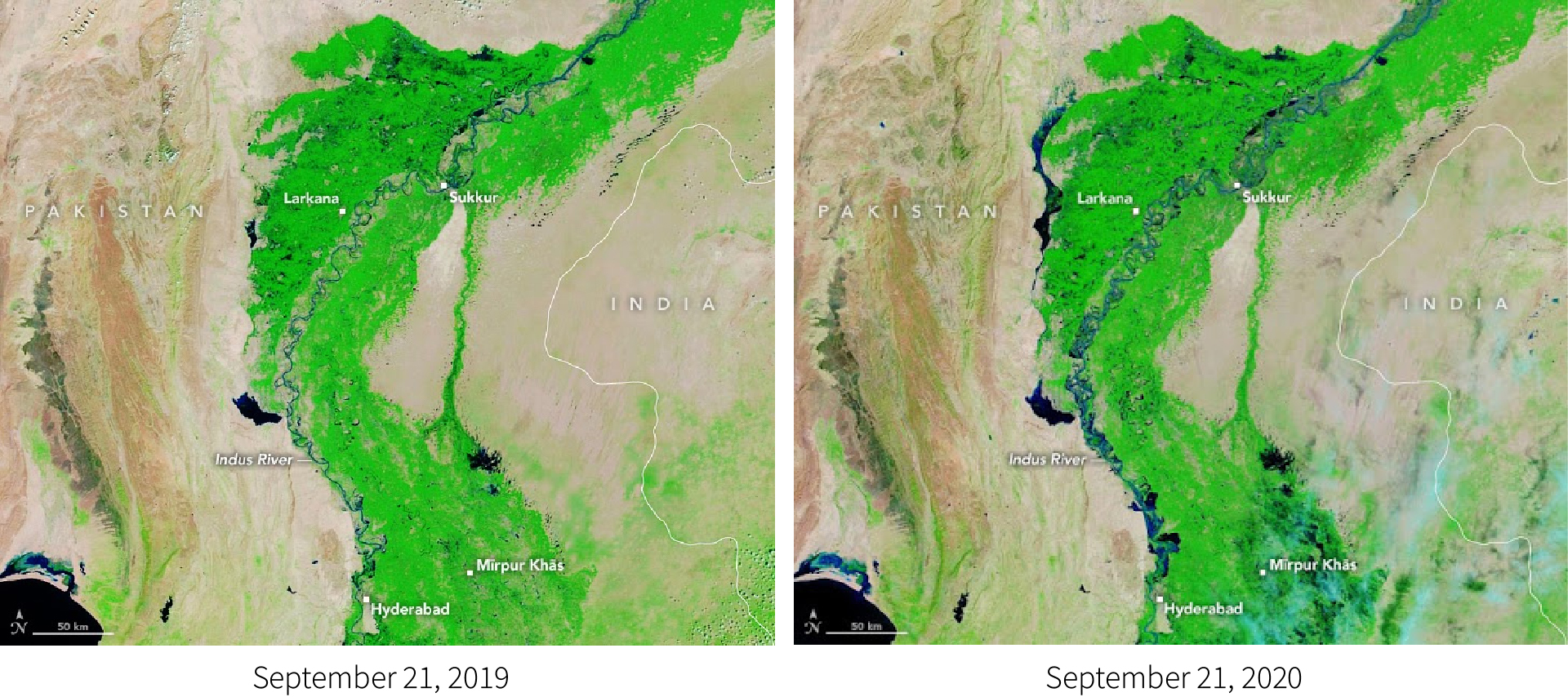Since mid-June 2020, the monsoon floods in Pakistan have caused over 400 deaths and damaged more than 200,000 homes. The Sindh Province, southeast of Pakistan, was the most heavily affected area, with over 68,000 people relocated to relief camps.
—
Lauren Dauphin from NASA Earth Observatory used MODIS data from NASA EOSDIS/LANCE and GIBS/Worldview to record the monsoon rains in the Sindh Province, comparing September 21st, 2019 and September 21st, 2020. The Moderate Resolution Imaging Spectroradiometer (MODIS) allows the combination of infrared and visible light, producing false-color images to facilitate water, land and vegetation differentiation.

Karachi, the capital of the Sindh Province, has received 490 millimeters of rain in August this year, receiving its largest recorded rainfall total in the month in 89 years. The Pakistan Meteorological Department reported heavy rains in late August in other parts of the province, including districts of Mīrpur Khās, Hyderabad, Sukkur, and Larkana. The Karachi, Hyderabad, and Mīrpur Khās districts were declared “calamity-affected areas.”
The heavy rainfall in Karachi was in part the result of a La Niña phenomenon, a regular oscillation in Pacific Ocean surface temperatures that could drive changes in rainfall. As of September 24th, 2020, the Pakistan Meteorological Department reported normal flow along the Indus River and other key rivers in Pakistan.
Since its creation in 1947, Pakistan has encountered around 38 floods of various magnitudes, in which about 50% were considered as major floods. Pakistan has varying geography with Northern alpine, where 5 major rivers – Indus and its tributaries are flowing through in Pakistan from south to north part. In addition to flooded rivers caused by monsoon rains, the major cause of the continuity of floods in Pakistan is the increase in snowmelt flows that results in intense rainfall in the rivers.
Monsoon rains come from June to September every year and they flood the Indus River. However, this year, Karachi has experienced its heaviest rainfall since 1931. In the week ending on August 28th, 2020, 760 mm of rainfall was recorded in a single week, signifying how climate change has contributed towards increased urban flooding.
This article was written by Jennie Wong. Photo by Jéan Béller on Unsplash
You might also like: Extreme Temperatures in India Will be Too Hot to Live In
References:
-
NASA Earth Observatory images by Lauren Dauphin, using MODIS data from NASA EOSDIS/LANCE and GIBS/Worldview.
-
Reuters, ‘Freak events’: Karachi floods hint at shifting monsoon, from: https://www.reuters.com/article/us-pakistan-monsoon-climatechange-idUSKCN26D1MS










![The Statistics of Biodiversity Loss [2020 WWF Report]](https://u4d2z7k9.rocketcdn.me/wp-content/uploads/2020/12/lprwinkyTHB-544x306.jpg)





